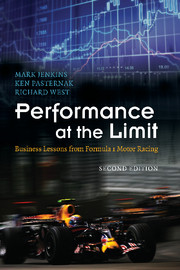
-
Select format
-
- Publisher:
- Cambridge University Press
- Publication date:
- 05 August 2013
- 23 April 2009
- ISBN:
- 9781107280182
- Dimensions:
- Weight & Pages:
- Dimensions:
- Weight & Pages:
- Subjects:
- Strategic Management, Management
You may already have access via personal or institutional login- Subjects:
- Strategic Management, Management
Book description
Can you imagine your organisation as a Ferrari or a McLaren, a Toyota or a Force India? Your management team as a pit crew? Your sales force as the race team and your marketing and research department as the design studio creating a Formula 1 car? Formula 1 has an estimated turnover of $4bn, employs 50,000 people in more than 30 countries and has a foothold in every major and developing economy. With performance as the central focus of every organization, Performance at the Limit uses the case of Formula 1 motorsport as an example of how business can achieve optimal performance in highly competitive environments where dealing with change effectively is paramount. This second edition builds on the success of the first and contains a wealth of new material, including many more interviews with Formula 1 drivers and other key executives active in the sport.
Reviews
‘Having worked recently with Ron Dennis, Chairman and Chief Executive of McLaren Racing, at the Leaders in London summit, I witnessed Ron hold the thousand-strong business audience enthralled by the wafer-thin margins between success and failure in Formula 1. It was a master class in the mentality of a winner. This book brings alive some of the very points that Dennis made so well at the conference and much more beyond; with accurate insights, great anecdotes and first-class analysis. Performance at the Limit articulates perfectly the split-second gap between also-ran, good and great. It’s all about leadership, preparation and amazing teamwork; without it you will simply fail to compete as those who have remained in pole position accepted long ago that 'good enough' is no longer good enough. So if you want to learn what it takes to get to the top and how to win, then this is the book for you.’
René Carayol - Inspired Leaders Network and Cass Business School
‘Formula 1 teaches us how to succeed in a challenging environment. The basic lesson is that it needs more than a skilled driver to win the race. In motorsports, change is a constant and being innovative is a necessity. To stay ahead of the competition, it is essential to have an excellent team on the track - a team showing an extraordinary performance and a passion for being the best. Performance at the Limit shows managers how these hard-won lessons can be applied to the ever-challenging world of business.’
Kasper Rorsted - Chief Executive Officer, Henkel
Contents
Metrics
Altmetric attention score
Full text views
Full text views help Loading metrics...
Loading metrics...
* Views captured on Cambridge Core between #date#. This data will be updated every 24 hours.
Usage data cannot currently be displayed.
Accessibility standard: Unknown
Why this information is here
This section outlines the accessibility features of this content - including support for screen readers, full keyboard navigation and high-contrast display options. This may not be relevant for you.
Accessibility Information
Accessibility compliance for the PDF of this book is currently unknown and may be updated in the future.


